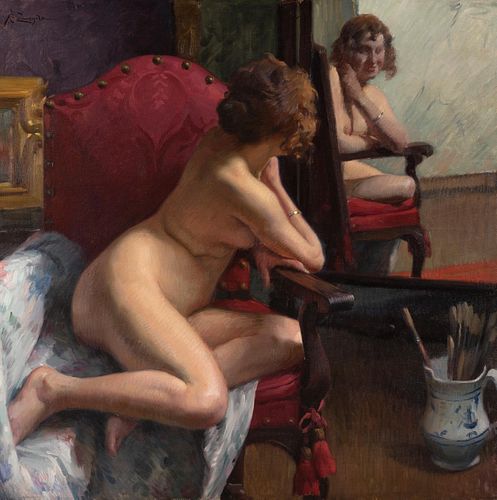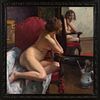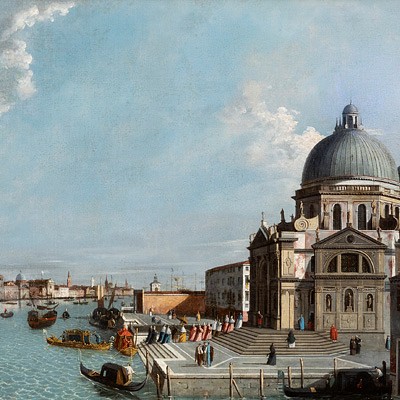JOSÉ RAMÓN ZARAGOZA (Cangas de Onis, Asturias, 1874 - Alpedrete, Madrid, 1947). "Female nude in front of the mirror." Oil on canvas. Signed in the
Lot 80
About Seller
Setdart Auction House
Carrer Aragó 346
Barcelona
Spain
Setdart Subastas was born in 2004 and is currently the first online art auction in Spain with solidity, prestige and reliability guaranteed by our more than 60,000 users. Setdart has a young, dynamic and enterprising team ready to successfully manage the purchase and sale of art works through custom...Read more
Categories
Estimate:
EUR€12,000 - EUR€15,000
$13,043.48 - $16,304.35
Absentee vs Live bid
Two ways to bid:
- Leave a max absentee bid and the platform will bid on your behalf up to your maximum bid during the live auction.
- Bid live during the auction and your bids will be submitted real-time to the auctioneer.
Bid Increments
| Price | Bid Increment |
|---|---|
| EUR€0 | EUR€10 |
| EUR€200 | EUR€25 |
| EUR€500 | EUR€50 |
| EUR€1,000 | EUR€100 |
| EUR€3,000 | EUR€200 |
| EUR€5,000 | EUR€500 |
| EUR€10,000 | EUR€1,000 |
| EUR€20,000 | EUR€2,000 |
| EUR€50,000 | EUR€5,000 |
About Auction
By Setdart Auction House
May 18, 2021
Set Reminder
2021-05-18 09:30:00
2021-05-18 09:30:00
America/New_York
Bidsquare
Bidsquare : Classics XIX and XX
https://www.bidsquare.com/auctions/setdart-auction-house/classics-xix-and-xx-6961
The next 18th May there will be a 19th and 20th Century Classics Auction at Setdart.com There will be a select repertoire of important artists such as Carlos Cruz Diez, Luis Feito, Joan Miró, Fernando Botero, Josep Llimona, Salvador Dalí among others. Setdart Auction House sofia@setdart.com
The next 18th May there will be a 19th and 20th Century Classics Auction at Setdart.com There will be a select repertoire of important artists such as Carlos Cruz Diez, Luis Feito, Joan Miró, Fernando Botero, Josep Llimona, Salvador Dalí among others. Setdart Auction House sofia@setdart.com
- Lot Description
JOSÉ RAMÓN ZARAGOZA (Cangas de Onis, Asturias, 1874 - Alpedrete, Madrid, 1947). "Female nude in front of the mirror." Oil on canvas. Signed in the upper left corner. Measurements: 112 x 112 cm; 127 x 127 cm (frame). It was exhibited in the exhibition-homage to the artist, held in the exhibition hall of the Municipal House of Culture of Cangas de Onis, in the spring of 2008. A young model, taking advantage of a break of the painter, entertains herself by contemplating herself in a large moon mirror, which allows us to admire her nudity from a double perspective. As usual in the painting of José Ramón Zaragoza, the naturalistic language is devoted to the enhancement of female sensuality, in its forms and freshness, but without idealizing it. The painter devotes the same attention to capture the smoothness of the velvet of the armchair, the fine porcelain of the jar with its brushes... It also highlights the compositional skill, in the play of reflections that expand the room translating its proportions with verism. A painter trained at the School of Arts and Crafts in Oviedo, José Ramón Zaragoza began his career in the last decade of the 19th century, taking part in the National Exhibitions of 1892 and 1897, obtaining an honorary mention in the latter year. That same year he received a scholarship from the Diputación de Asturias to continue his studies at the Escuela de San Fernando in Madrid, where his teacher was Menéndez Pidal. He continued showing his works in the National Exhibitions, and in 1901 and 1906 he obtained a second medal. In 1904 he was awarded a scholarship to further his education in Rome, and he remained there until 1910. He also traveled to Paris and London, and toured Holland, Germany and French Brittany. On his return, one of the portraits he painted on this trip won him the first medal at the 1915 National Exhibition. Also, during his tour through Europe he participated in international exhibitions, being awarded the second medal at the Universal of Munich in 1913 and an honorable mention at the Paris Salon of 1914. As an individual, he exhibited in 1923 at the Museum of Modern Art in Madrid. He also made decorative projects, such as the three panels painted for the Círculo de Bellas Artes of the capital in 1925. Three years later he was appointed, by competitive examination, professor of the School of Arts and Crafts of the same city and in 1930, also by competition, professor of painting at San Fernando. He was appointed a full member of the Royal Academy of Fine Arts in 1948, shortly after his death. He is currently represented in the Museum of Fine Arts of Asturias, the City Council of Oviedo, the Círculo de Bellas Artes of Madrid and the Jovellanos Institute of Gijón, among other collections.
- Shipping Info
-
In-House Shipping
-
- Buyer's Premium



 EUR
EUR CAD
CAD AUD
AUD GBP
GBP MXN
MXN HKD
HKD CNY
CNY MYR
MYR SEK
SEK SGD
SGD CHF
CHF THB
THB
















